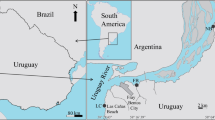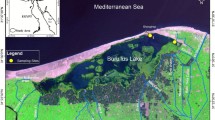Synopsis
The Aufwuchs-eating cichlids of Lake Tanganyika show clear trophic differences that are correlated to their morphology, physiology and foraging behaviour. The species are grouped into three categories of relative intestinal length according to their feeding habits. A correlation between the intestinal length and the diet could be demonstrated, ranging from around 2.5 for species ingesting more animal food, to 7.8 for detritivorous and microalgivorous species. The relative intestinal length of domesticTropheus moorii, raised in aquaria was significantly lower than that of wild individuals by a factor of 1.7, demonstrating a wide range of phenotypic adaptability. The activities of trypsin and amylase were at an equal level in four Aufwuchseating species, but the activity of laminarinase of a detritivorous-microalgivorous species (Petrochromis orthognathus) was 2.6 times higher than that of an algivorous species (Tropheus moorii). The laminarinase seems to be an excellent marker enzyme for detritivorous or microalgivorous feeding.
Similar content being viewed by others
References cited
Bergmeyer, H.U. (ed.) 1974. Methods in enzymatic analysis. Verlag Chemie, Weinheim. Vol. 1, pp. 1060–1062.
Echelle, A.A. & I. Kornfieldes flocks. University of Maine Press, Orono. 257 pp.
Fryer, G. & T.D. Iles. 1972. The cichlid fishes of the great lakes of Africa. Oliver & Boyd, Edinburgh. 641 pp.
Greenwood, P.H. 1959. The monotypic genera of cichlid fishes in Lake Victoria, Part II. Bull. Brit. Mus. Nat. Hist. (Zool.) 5: 165–177.
Greenwood, P.H. 1965. Environmental effects on the pharyngeal mill of a cichlid fish,Astatoreochromis alluaudi and their taxonomic implications. Proc. Linn. Soc. London 176: 1–10.
Hofer, R. 1979a. The adaption of digestive enzymes to temperature, season and diet in roachRutilus rutilus L. and ruddScardinius erythrophthalmus L. — Amylase. J. Fish Biol. 14: 565–572.
Hofer, R. 1979b. The adaption of digestive enzymes to temperature, season and diet in roachRutilus rutilus L. and ruddScardinius erythrophthalmus L. — Proteases. J. Fish Biol. 15: 373–379.
Hofer, R. 1988. Morphological adaptations of the digestive tract of tropical cyprinids and cichlids to diet. J. Fish Biol. 33: 399–408.
Hofer, R. & G. Köck. 1989. Method for qualitative determination of digestive enzymes in fish larvae. Pol. Arch. Hydrobiol. 36: 439–441.
Hofer, R. & F. Schiemer. 1981. Proteolytic activity in the digestive tract of several species of fish with different feeding habits. Oecologia 48: 342–345.
Hoogerhoud, R.J.C. 1986. Taxonomic and ecological aspects of morphological plasticity in molluscivorous haplochromines (Pisces, Cichlidae). Ann. Mus. Roy. Afr. Centr. Sc. Zool. 251: 131–134.
Hynes, H.B.N. 1950. The food of freshwater sticklebacks (Gasterosteus aculeatus andPygosteus pungitius), with a review of methods used in studies of the food of fishes. J. Animal Ecol. 19: 36–58.
Kawai, S. & S. Ikeda. 1972. Studies on the digestive enzymes of fishes — II. Effect of dietary changes on the activities of digestive enzymes in carp intestine. Bull. Jap. Soc. Sci. Fish 38: 265–270.
Köck G. & R. Hofer. 1989. The effect of natural and artificial diets upon tryptic activity of roach (Rutilus rutilus) and whitefish (Coregonus sp.) larvae. Pol. Arch. Hydrobiol. 36: 443–453.
Kornfield, I. & J.N. Taylor. 1983. A new species of polymorphic fish,Cichlasoma minckleyi, from Cuatro Cienegas, Mexico (Teleostei: Cichlidae). Proc. Biol. Soc. Wash. 92: 253–269.
Liem, K.F. 1973. Evolutionary strategies and morphological innovations: cichlid pharyngeal jaws. Syst. Zool. 22: 425–441.
Liem, K.F. 1980. Adaptive significance of intra- and interspecific differences in the feeding repertoire of cichlid fishes. Amer. Zool 20: 295–314.
Liem, K.F. 1984. Functional versatility, speciation and niche overlap: are fishes different? pp. 269–305. In: D.G. Meyers & J. R. Strickler (ed.) Trophic Interactions Within Aquatic Ecosystems, AAAS Selected Symposium 1985.
Liem, K.F. & J.W. Osse. 1975. Biological verstility, evolution and food resource exploitation in African cichlids. Amer. Zool. 15: 427–454.
Mbomba, N.B. 1983. Comparative morphology of the feeding apparatus in cichlidian algal feeders of Lake Tanganyika. Afr. Stud. Monogr. 3: 1–23.
Mbomba, N.B. 1986. Comparative feeding ecology of Aufwuchs eating cichlid fishes in Lake Tanganyika with reference to their developmental changes. Physiol. Ecol. Japan 23: 79–108.
McKaye, K.R. & A. Marsh. 1983. Food switching by two specialized algae-scraping cichlid fishes in Lake Malawi, Africa. Oecologia 56: 245–248.
Meyer, A. 1987. Phenotypic plasticity and heterochrony inCichlasoma managuense (Pisces, Cichlidae) and their implications for speciation in cichlid fishes. Evolution 41: 1357–1369.
Meyer, A. 1990a. Ecological and evolutionary consequences of the trophic polymorphism inCichlasoma citrinellum (Pisces: Cichlidae). Biol. J. Linn. Soc. 39: 279–299.
Meyer, A. 1990b. Morphometrics and allometry in the trophically polymorphic cichlid fish,Cichlasoma citrinellum: alternative adaptations and ontogenetic changes in shape. J. Zool. Lond. 221: 237–260.
Nagase, G. 1964. Contribution to the physiology of digestion inTilapia mossambica Peters: digestive enzymes and the effects of diet on their activity. Z. vergl. Physiol. 49: 270–284.
Niederholzer, R. & R. Hofer. 1979. The adaption of digestive enzymes to temperature, season and diet in roachRutilus rutilus L. and ruddScardinius erythrophthalmus L. — Cellulase. J. Fish Biol. 15: 411–416.
Piavaux, A. 1972. Intestinal laminarinase of a vertebrate:Tilapia macrochir Boulenger (Teleostei, Cichlidae). Life Sciences 11: 185–190.
Piavaux, A. 1977. Distribution and localization of the digestive laminarinases in animals. Biochem. System. Ecol. 5: 231–239.
Piavaux, A. & G. Dandrifosse. 1972. Presence de laminarinases dans l'intestin d'un poisson cichlidaeTilapia macrochir Boulenger. Arch. Int. Physiol. Biochim. 80: 51–57.
Reinthal, P.N. 1990. The feeding habits of a group of herbivorous rock-dwelling cichlid fishes (Cichlidae: Perciformes) from Lake Malawi, Africa. Env. Biol. Fish. 27: 215–233.
Ribble, D.O. & M.H. Smith. 1983. Relative intesine length and feeding ecology of freshwater fishes. Growth 47: 292–300.
Sturmbauer, C. 1990. Vergleichende Untersuchungen zur Physiologie und Ethologie herbivorer Fische. Thesis, University of Innsbruck, Innsbruck, 130 pp.
Sturmbauer, C. 1991. Different enzymes for laminarine digestion inChondrostoma nasus (Cyprinidae) andOreochromis sp. (Cichlidae). Comp. Biochem. Physiol. B100: 199–202.
Sturmbauer, C. & R. Hofer. 1986. Compensation for anylase inhibitors in the intestine of the carp (Cyprinus carpio). Aquaculture 52: 31–33.
Takamura, K. 1983. Interspecific relationship between two Aufwuchs-eatersPetrochromis polyodon andTropheus moorii (Pisces, Cichlidae) of Lake Tanganyika, with a discussion on the evolution and functions of a synbiotic relationship. Physiol. Ecol. Japan 20: 59–69.
Takamura, K. 1984. Interspecific relationships of Aufwuchseating fishes in Lake Tanganyika. Env. Biol. Fish. 10: 225–241.
Witte, F. 1984. Consistency and functional significance of morphological differences between wild-caught and domesticHaplochromis squamipinnis (Pisces: Cichlidae). Netherl. J. Zool. 34: 596–612.
Witte, F., C.D.N. Barel & R.J.C. Hoogerhoud. 1990. Phenotypic plasticity of anatomical structures and its ecomorphological significance. Netherl. J. Zool. 40: 278–298.
Yamaoka, K. 1982. Morphology and feeding behaviour of five species of genusPetrochromis (Teleostei, Cichlidae). Physiol. Ecol. Jap. 19: 57–75.
Yamaoka, K. 1983. Feeding behaviour and dental morphology of algae scraping cichlids (Pisces: Teleostei) in lake Tanganyika. Afr. Stud. Monogr. 4: 77–89.
Yamaoka, K. 1988. Comparative osteology of the suspensoral complex of algal-feeding cichlids (Pisces, Teleostei) from Lake Tanganyika. Afr. Stud. Monogr. 9: 65–84.
Yamaoka, K., M. Hori & S. Kuratani. 1986. Ecomorphology of feeding in ‘goby-like’ cichlid fishes in Lake Tanganyika. Physiol. Ecol. Jap. 23: 17–29.
Zihler, F. 1982. Gross morphology and configuration of digestive tracts of cichlidae (Teleostei, Perciformes): phylogenetic and functional significance. Netherl. J. Zool. 32: 544–571.
Author information
Authors and Affiliations
Rights and permissions
About this article
Cite this article
Sturmbauer, C., Mark, W. & Dallinger, R. Ecophysiology of Aufwuchs-eating cichlids in Lake Tanganyika: niche separation by trophic specialization. Environ Biol Fish 35, 283–290 (1992). https://doi.org/10.1007/BF00001895
Received:
Accepted:
Issue Date:
DOI: https://doi.org/10.1007/BF00001895




